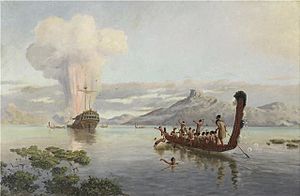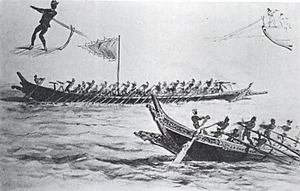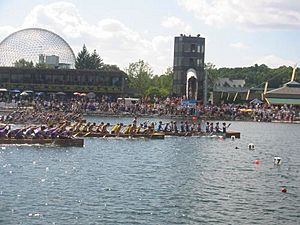War canoe facts for kids

A war canoe is a special type of watercraft or canoe. It was designed and used for fighting. You can find different kinds of war canoes in many cultures around the world. Today, "war canoe" can also mean a type of racing canoe used in sports.
Contents
History of War Canoes

People used war canoes in Africa, Austronesia, the Americas, and Europe. They helped move soldiers and supplies. They also attacked targets on land.
While we don't have many stories of canoe battles on the open ocean, old records tell us about huge fighting canoes. In the 14th century, people in West Africa used them in rivers and lakes. Some of these canoes were up to 80 feet (24 meters) long. They could carry over 100 people!
How War Canoes Were Built
War canoes were usually made from one very large tree trunk. The silk cotton tree was a popular choice. Workers dug out and shaped the inside using fire and hand tools. They used braces to stop the wood from spreading too much while it was being treated with fire. The fire also helped release sap, which protected the wood from insects. Some canoes were 7 to 8 feet (2 to 2.4 meters) wide inside. They had benches for paddlers and even places to sleep or cook.
Weapons and Tactics
Warriors on these canoes often carried shields, spears, and bows. Later, when gunpowder was invented, some canoes had small iron or brass cannons. These cannons were placed at the front or back, but they weren't very powerful. Soldiers with muskets (old guns) had more success. They would shoot to cover raiding parties.
A common tactic was to paddle close to shore, fire their weapons, and then quickly pull back to open water. They would reload there, then dash in again to repeat the attack. Moving troops and supplies was their main job. But battles between canoes also happened often in the lagoons, creeks, and lakes of West Africa.
Canadian Sport War Canoes
War canoe racing is mostly a Canadian sport. Some teams also come from the northwestern United States. It's not part of the International Canoe Federation, but it's a big part of many Canadian canoe clubs. The name "war canoe" comes from the large canoes used by indigenous peoples for war. War canoeing was popular in Vancouver, British Columbia, a long time ago. Today, war canoeing is becoming popular again among indigenous communities.
How the Sport Works
A war canoe holds 15 paddlers, including one person who steers. This person is called a "coxswain" or "cox." You might see war canoe races called C-15 on schedules, where 'C' means 'canoe'.
The paddlers kneel on one knee while they paddle. There are 7 paddlers on each side, slightly offset from each other. The coxswain stands at the back, bracing their legs. Paddlers on the left side kneel on their left knee, and those on the right kneel on their right knee. The paddler at the very front sets the pace for everyone else.
Most war canoes are made of wood. However, some newer ones are made of fiberglass. Races are usually 500 meters or 1000 meters long. Paddles can be made of wood, but carbon fiber paddles are now common. They are lighter, which helps teams go faster.
Teamwork and Competition
War canoe is a very important event at races. It lets a large part of a club's members race together as a team. This is special because many other canoe sports focus on individual achievements. Teams are made up of paddlers from different age groups, like junior or masters. There are races for men's, women's, and mixed teams.
War canoes are usually faster than dragon boats over the same distance. This is because war canoes have a better shape. They are narrower and lighter. Also, kneeling lets paddlers take a stronger, more powerful stroke than sitting down.
See also
- Tomako
- Pacific Northwest Canoes
- Dragon boat
- Sprint canoe
- Canoe racing
- Waka
- Kakap
- Swan boat (racing)
- Nouka Baich
- Chundan vallam



